The Zeppelin Airships
Part One: The First Zeppelin Airships 1910 - 1914
LZ-1 |
Usage: |
prototype |
First Flight: |
02 July 1900 |
Length: |
416 feet / 124.8 meters |
Diameter: |
38.2 feet / 11.64 meters |
Gas Volume: |
399,000 cu. feet / 11,970 cu. meters |
Engines: |
Two 14.7 hp Daimler engines |
Maximum Speed: |
17.3 mph / 27.7 km/h |
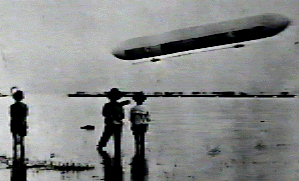 |
The first Zeppelin flight occurred on 2 July 1900 over Lake Constance in Bavaria. It lasted for only 18 minutes before the LZ-1 was forced to land on the lake after the winding mechanism for the balancing weight broke. Once repaired, zeppelin technology proved its potential: her second flight was in early October 1900, and her third and final flight was on 24 October 1900. With his financial resources depleted, Graf von Zeppelin was forced to disassemble the prototype, sell it for scrap, and close the company.
|
LZ-2 |
Usage: |
experimental |
First Flight: |
17 January 1906 |
Donations and the profits of a special lottery, together with some public funding and a further 100,000 Mark contribution by Graf von Zeppelin himself allowed for the construction of LZ-2, which took off for the first and only time on 17 January 1906. After both motors failed, she made a forced landing in the Allgäu mountains, where she was subsequently damaged beyond repair in a storm.
|
LZ-3 |
Tactical*: |
Z I |
Usage: |
experimental, military |
First Flight: |
09 October 1906 |
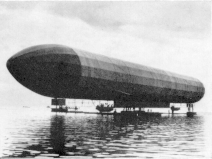 |
LZ-3 incorporated all parts of LZ-2 that were still usable. She became the first truly successful Zeppelin, and by 1908 she had traveled 4,398 km in the course of 45 flights. Now the technology interested the German military, who bought LZ-3 and renamed her Z I. She served as a school ship until 1913, by which time she was considered obsolete and decommissioned.
|
LZ-4 |
Usage: |
military (intended) |
First Flight: |
20 June 1908 |
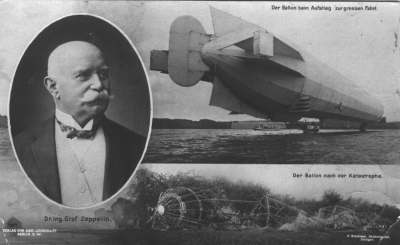 |
The German army was willing to purchase LZ-4. While attempting to fulfill a military 24-flight requirement, the crew of LZ-4 made an intermediate landing in Echterdingen near Stuttgart. During the stop, a storm tore the airship away from its anchorage on the afternoon of 5 August 1908. The airship crashed into a tree, caught fire, and quickly burnt to ruins. No one was seriously injured, although two technicians escaped only by making a hazardous jump. The accident turned out to be a blessing is disguise, for one of the spectators in the crowd initiated a collection for donations that yielded an amazing 6,096,555 Marks. This enabled the Graf to found a company to build his airships, Luftschiffbau Zeppelin GmbH. The Zeppelin project not only rose like a Phoenix from the ashes, but was at last financially secure.
|
LZ-5 |
Tactical*: |
Z II |
Class: |
Type M |
Usage: |
experimental, military |
First Flight: |
26 May 1909 |
 |
LZ-5 was turned over to the German army upon completion of her trials. They managed to strand her near Weilburg in 1910 during a storm. The damaged ship was subsequently scrapped. |
 Anatomy of the LZ-5 Class |
|
LZ-6 |
Class: |
Type M |
Usage: |
passenger (DELAG) |
First Flight: |
25 August 1909 |
Passengers: |
24 |
 |
LZ-6 conducted the first Zeppelin experiments with wireless communication. She was the prototype of the so-called LZ-6 Class of passenger airships, becoming the first commercial passenger Zeppelin. For this purpose, she was taken over by the world's first airline, the newly founded Deutsche Luftschiffahrts-AG (DELAG). She was accidentally destroyed in her hall in Baden-Oos in 1910.
|
LZ-7 Deutschland |
Class: |
Type M |
Usage: |
DELAG |
First Flight: |
19 June 1910 |
Passengers: |
24 |
She was damaged beyond repair in an accident above the Teutoburg Forest on 28 June 1910.
|
LZ-8 Deutschland II |
Class: |
Type M |
Usage: |
DELAG |
First Flight: |
30 March 1911 |
Passengers: |
24 |
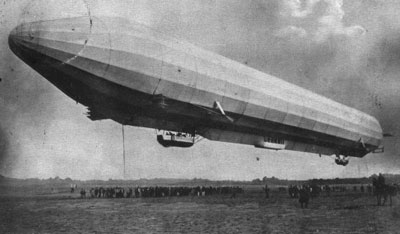 |
She was pushed to the wall of her hall by strong wind and damaged beyond repair on 16 May 1911.
|
LZ-9 |
Tactical*: |
Z II (second ship to bear this designation) |
Usage: |
military |
First Flight: |
2 October 1911 |
LZ-9 served in the German army for nearly three years before being decommissioned 1 August 1914 as obsolete.
|
LZ-10 Schwaben |
Class: |
Type M |
Usage: |
DELAG |
First Flight: |
26 June 1911 |
Passengers: |
24 |
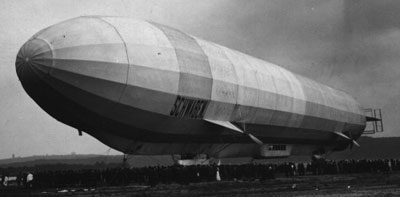 |
During her single year of service, LZ-10 Schwaben transported 4,354 passengers in 224 flights, travelling some 27,321 km. She was destroyed on 28 June 1912 in accident on the airfield in Dhüsseldorf.
|
LZ-11 Viktoria Luise |
Class: |
Type M |
Usage: |
DELAG, later military |
First Flight: |
12 February 1912 |
Passengers: |
24 |
 |
LZ-11 Viktoria Luise transported 9,783 passengers in 489 flights, travelling 54,312 km. At the outbreak of World War I, she was taken over as school ship by German military. She broke apart while being "halled in" by a trainee ground crew on 8 October 1915.
|
LZ-12 |
Tactical*: |
Z III |
Class: |
Type M |
Usage: |
military |
First Flight: |
25 April 1912 |
LZ-12 served in the German army for only a few years before being decommissioned 1 August 1914 as obsolete.
|
LZ-13 Hansa |
Usage: |
DELAG, later military |
First Flight: |
30 July 1912 |
Passengers: |
24 |
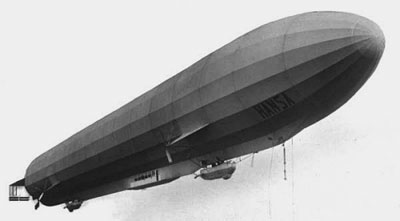 |
LZ-13 Hansa travelled 44,437 km in 399 flights. She flew the first regular passenger run outside Germany, to Denmark and Sweden. She was taken over by German military upon outbreak of World War I and decommissioned in the summer of 1916.
|
LZ-14 |
Tactical*: |
L 1 |
Usage: |
military |
First Flight: |
7 October 1912 |
LZ-14 crashed into the North Sea during a thunderstorm on 9 September 1913, drowning 14 crewmembers. This was the first Zeppelin incident in which fatalities occurred.
|
LZ-15 |
Tactical*: |
Z I (second ship to bear this designation) |
Usage: |
military |
First Flight: |
16 January 1913 |
LZ-15 was destroyed in a forced landing on 19 March 1913.
|
LZ-16 |
Tactical*: |
Z IV |
Usage: |
military |
First Flight: |
14 March 1913 |
The German army continued to have little luck with airships. LZ-16 accidentally crossed the French border on 3 April 1913 in misty weather. She was kept in Lunéville by the French army for a day. During the war, she performed reconnaissance missions and bombed Warsaw and Lyck. She was used as a school ship after 1915 and was decommissioned in the autumn of 1916.
|
LZ-17 Sachsen |
Usage: |
DELAG, later military |
First Flight: |
3 May 1913 |
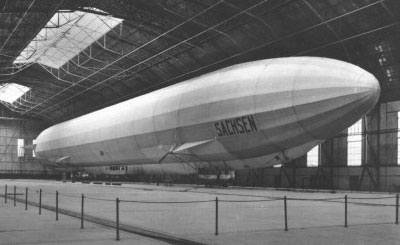 |
LZ-17 Sachsen transported 9,837 passengers in 419 flights, travelling 39,919 km. She was taken over by German military upon outbreak of World War I and decommissioned in the autumn of 1916. She was the last commercial airship built until after World War I.
|
LZ-18 |
Tactical*: |
L 2 |
Usage: |
military |
First Flight: |
9 September 1913 |
LZ-18 was destroyed on 17 October 1913 when an engine exploded during a test flight. The entire crew was killed.
|
LZ-19 |
Tactical*: |
Z I (third ship to bear this designation) |
Usage: |
military |
First Flight: |
6 June 1913 |
LZ-19 was damaged beyond repair in a thunderstorm on 13 April 1914 and subsequently scrapped.
|
LZ-20 |
Tactical*: |
Z V |
Usage: |
military |
First Flight: |
8 July 1913 |
LZ-20 was used by the German army for reconnaissance missions in western Poland during World War I. She was forced down after an attack on Mlawa during the Battle of Tannenberg. The crew was captured by enemy cavalry while trying to burn the ship.
|
LZ-21 |
Tactical*: |
Z VI |
Usage: |
military |
First Flight: |
8 July 1913 |
LZ-21 was used by the German army in World War I mainly in Belgium as a bomber. She was damaged beyond repair during a bombing of Liège on 6 August 1914.
|
LZ-22 |
Tactical*: |
Z VII |
Usage: |
military |
First Flight: |
8 January 1914 |
Length: |
150 meters |
Gas Volume: |
22,000 cu. meters |
Engines: |
Three 400hp Maybach motors |
Maximum Speed: |
80 kph |
LZ-22, accompanied by LZ-23, was hit by infantry fire during a reconnaissance mission in Alsace on 21 August 1914 and was damaged beyond repair in a subsequent forced landing in St. Quirin, Lorraine.
|
LZ-23 |
Tactical*: |
Z VIII |
Usage: |
military |
First Flight: |
11 May 1914 |
LZ-23 accompanied LZ-22 on her ill-fated mission into Alsace. She was forced to land behind enemy lines, where she was captured and plundered by the French army.
|
LZ-24 |
Tactical*: |
L 3 |
Usage: |
military |
First Flight: |
11 May 1914 |
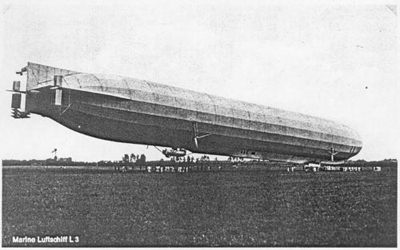 |
LZ-24 participated in 24 reconnaissance missions over the North Sea, including the first raid of England on 20 January 1915. She was scuttled by her crew after a forced landing caused by engine failure in Denmark on 17 February 1915.
|
LZ-25 |
Tactical*: |
Z IX |
Usage: |
military |
First Flight: |
13 July 1914 |
 |
LZ-25 was used for reconnaissance missions and bombing in northern France. She was destroyed by English bomber in her hall in Düsseldorf on 8 October 1914. She was the last zeppelin built before the outbreak of the Great War.
|
NOTE: Tactical refers to the airship's tactical designation(s). The Z designation indicates an airship operated by the German army, whereas the L designation indicates an airship operated by the German navy. During the war, the army changed their scheme twice: following Z XII, they switched to using the LZ numbers, later adding 30 to obscure the total number in production.
Copyright ©2007 Puget Sound Airship Society
|
 |
|
